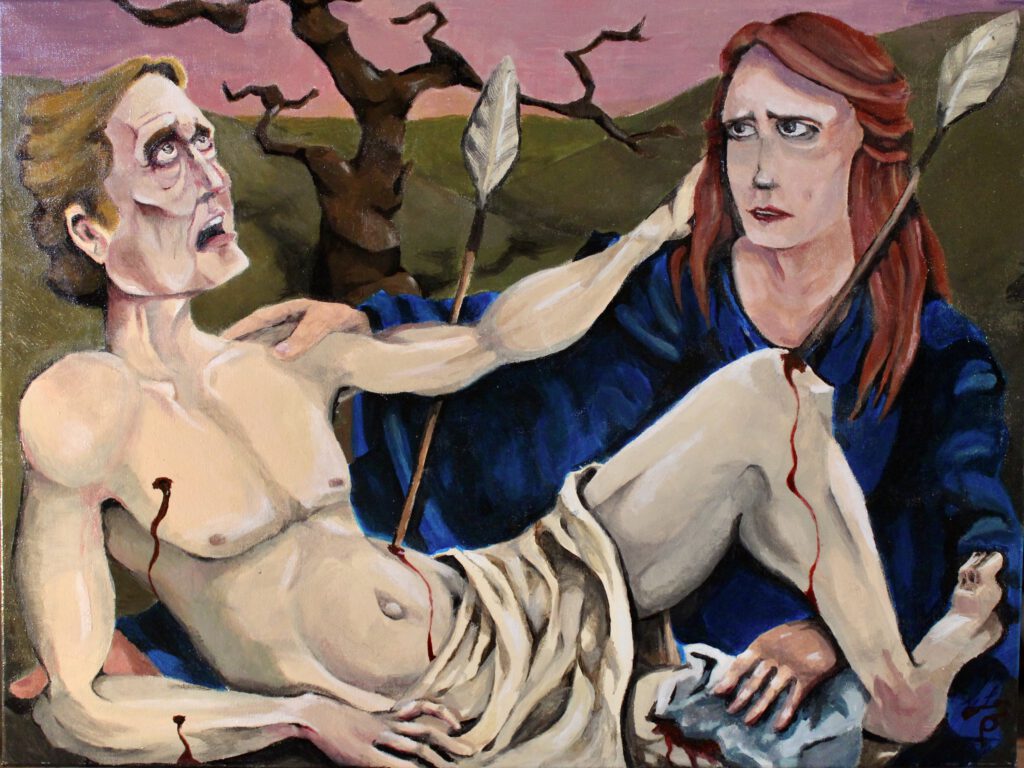Dedicated to the people in Lombardy and everyone else suffering from the current situation, we recorded a fifteenth-century Netherlandish-Lombardinian healing motet written for Saint Sebastian. (The recording was made with limited resources and in strict abidance by Dutch governmental Corona measures.) The motet accompanies a painting made by our friend Koen Leenaers, depicting Sebastian tended by Saint Irene, who helped him down from the tree on which he was pierced with arrows. She took him home with her and nurtured him back to health.
After the Lombardinians raised an altar for Saint Sebastian in the seventh century, they were promptly released from the Plague that had struck their region. This miracle gave Sebastian, in the whole of Europe, the reputation of a saint on which to call upon in times of plague. At the end of the fifteenth century, this moved the Flemish-Netherlandish Gaspar van Weerbeke, working at the Milanese court in the same region, to write a healing motet recalling the miracle and begging Sebastian for a new one: plague had struck again in Lombardy between 1481 and 1487 and Milan had been suffering for years. Almost every year, the disease sprang up in different parts of Europe.
Prima pars: O beate Sebastiane, miles beatissime cuius precibus tota patria Lombardie fuit liberata a pestifera peste. Secunda pars: Libera nos ab ipsa et a maligno ut digni efficiamur promissionibus Christi.
(O blessed Sebastian, the most holy soldier, by whose prayers the entire land of Lombardy was liberated from the pestiferous plague. Free us from the same and from evil so that we may be made worthy of the promises of Christ.)
Renaissance doctors knew much less about hygiene and medicine than doctors do nowadays, but in terms of holistic approach we might be able to learn a thing or two from them. In many medical tractates the enjoyment of art and music in a small circle of close friends and family (and avoiding large crowds), is prescribed as a serious medicine for preventing disease. For example, Niccolo Massa writes in his sixteenth-century plague tract: “Many people, from fear and imagination alone, have fallen to pestilential fever; therefore, it is necessary to be joyful … One should stay in a beautiful place, such as a bright home adorned with tapestries … Furthermore, the soul gladdens in meeting dear friends and in talking of joyful and funny things. It is especially advantageous to listen to songs and lovely instrumental music … to look at pictures that please the eyes …” (Liber de febre pestilentiali, ac de pestichiis, Venice, 1550). So, while Sebastian was primarily called upon for divine intervention, the motet of Gaspar might have had, in the eyes of those doctors, a genuine healing potential.
With international struggle being as much a part of the political discourse as it is today, the Milanese duke and many other patrons at European courts and institutes still took their doctor’s advice to heart, and actively promoted the exchange of art and artists across their borders, as well as providing financial support. This offered hundreds of painters, sculptors, composers and musicians an inspirational intellectual community. Art at courts and churches, as well as street performance and dance, was seen as a fundamental factor in shaping a healthy society.
Gaspar’s motet was originally written to save the people of northern Italy from disease. During the current pandemic, Lombardy in particular has suffered immensely under the coronavirus disease. It would be bold to try and heal the ill by singing early music. But with entire continents, countries and even close-knit neighbourhoods being separated, we can attempt to build bridges across currently closed borders. One way is by means of bringing to light our shared cultural heritage. We hope that this motet and Koen’s newly painted image of Sebastian and Irene, can contribute towards historical and future connections.
—
Music: O Beate Sebastiane (Gaspar van Weerbeke, c. 1445 – d. after 1517) Painting: Saint Sebastian Tended by Saint Irene, by Koen Leenaers
For further reading on the healing qualities of Gaspar’s motet and music in general during times of plague in the Renaissance: Remi Chiu, “Music, Pestilence and Two Settings of O Beate Sebastiane”, Early Music History (2012) Vol. 31. p.153-188.
Watch on youtube: https://youtu.be/uTLDqm9rgQs.
